THE discovery of royal tombs at Ur of the Chaldees is the out-standing feature of the sixth campaign of the Joint Expedition. If the report of Mr. C. Leonard Woolley reads somewhat like a story of the Thousand and One Nights, it simply proves that an ancient and sumptuous civilization had foretold in the same land the glory of a Caliph of Baghdad. The work on the cemetery which began on October 17th, under the same staff as last year, ended on January 7th. The work on the Great Courtyard building which followed and will occupy the latter part of the season will be reported in a later number of the JOURNAL.
The complete report on the discovery of the royal tombs will fulfil the promises made in the last number of the MUSEUM JOURNAL. The rich tombs of King Mes-Kalam-Dug and of Queen Shub-ad were found intact. Three other tombs were unfortunately plundered. The tombs were discovered in the following order:
- Tomb of Mes-Kalam-Dug.
- A plundered two-chamber tomb.
- First area or shaft where singers, harp player, chariot, grooms, and furniture were buried over a plundered tomb.
- Second area, one metre and a half below, containing fifty-eight bodies placed round the intact vaulted tomb of Queen Shub-ad.
- A plundered, stone-vaulted, three-chamber tomb below that of Mes-kalam-dug.
The shaft graves are a remarkable feature which throws a new light on early Sumerian burial customs. The connection between the two large areas and their central tombs is somewhat doubtful. In fact the intact tomb of Queen Shub-ad, while at a slightly lower level, abuts upon the plundered tomb (C). Mr. Woolley is inclined to attribute the queen’s tomb to the higher level (C), and the plundered king’s tomb to the lower (D) area. His report will make this clearer.
L. L.

Image Number: 190960, 191102

Image Number: 190937
Resuming Work on the Cemeteries
The first part of our programme was to continue the excavation of the early cemeteries, and a large area adjoining that dug last year was marked out and work begun from the top level, the object being to remove and distinguish carefully between the successive strata. The present flat surface is due partly to denudation and partly to the filling up of hollows in the Third Dynasty and Larsa periods. All the graves below that surface have belonged to two earlier periods, the Sargonid and the First Dynasty of Ur, and their contents show a marked difference from those of the earliest times discovered last year; the pottery and the metal weapons, etc., are of other types, and although there is a quite obvious continuity of culture, there is equally clear evidence for a long lapse of time between the first and the second periods of the cemetery.

The graves have proved very rich: gold objects have been found every day since work started, the most curious being a gold amulet in the form of a phallus, a very rare thing in this country where phallic rites were to say the least of it uncommon; also curious are coils of narrow gold ribbon probably twisted round braids of hair and worn across the forehead. The bulk of the gold comes from the grave in which the gold dagger was found last year; its excavation had been left unfinished and was resumed this year. The best object is a composite bead, probably from a tasselled cord, formed of four double conoid beads soldered together and decorated with applied filigree work exactly like that of the dagger: with this were found hundreds of gold beads and pendants, many of them finely worked, and great quantities of beads in lapis and carnelian; a finger ring of gold cloisonné work set with lapis came to light and is a remarkable specimen of technique.
Quite exceptional are the cylinder seals, of which very many have been found. No previous season has produced anything so fine and the illustrations of a few of them will give an idea of the quality of the seals of the period. In several cases the gold or copper caps have been preserved and add greatly to the appearance of the stones.

Museum Object Numbers: 29-22-10A / 29-22-10B
Image Number: 8331
Discovery of the Grave of King Mes-Kalam-Dug (A)
The grave is of the normal type, but was signalized by having at its head a spear stuck upright in the soil; the head of the spear is of copper, the shaft plated with gold. Round the wooden coffin were numerous vessels of stone, clay, copper, and silver, and one magnificent bowl of yellow gold richly ornamented with fluting and engraving; the silver vessels include a number of bowls, a lamp, and a libation jug of large size. With these were many weapons, spears, axes, daggers, etc. Of the daggers two had gold hilts and one a silver hilt, the last much perished. Inside the grave was a silver lamp near the feet. On one side of the body were a mass of earrings in gold and silver, a gold pin with lapis head, a wreath of gold mulberry leaves and beads; on the other side a vast number of beads in lapis and gold forming various necklaces, and with them a lapis figure of a ram, another of a frog, and an exquisitely worked miniature figure of a monkey in gold. Near the head were a lamp, an oval boat-shaped bowl, and a hemispherical bowl all of solid gold (or electrum?), each inscribed with the name of the owner, Mes-Kalam-Dug. Over the head was the most remarkable object yet found in our excavations, a peruke in solid gold, life size, and intended to be worn on the head; the hair is beautifully engraved, there is a bandeau round the forehead, and the headdress descends over the cheeks to the level of the chin, representing whiskers. A two-headed gold axe lay by the shoulder. Beyond all question this is the finest discovery that has yet been made in Mesopotamian archaeology. Among the objects found in the coffin was a silver belt to which were attached a whetstone and a dagger; the whet-stone is of lapis lazuli hung on a gold ring, the dagger has a gold blade and a hilt originally of silver ornamented with gold, and the sheath was of silver. The silver has perished (that of the hilt completely so, for it was of thin metal over wood), but it can easily be restored. From a corroded mass of gold and silver earrings, etc., found by the left hand of the body I have extricated an axe of normal type but in gold (or electrum). The corroded lump of metal vases found outside the head of the coffin, which had already yielded the decorated gold bowl and the silver libation jug, has been separated and has further produced a plain bowl and a drinking cup, both of gold.

Image Number: 190963

The Two-Chamber Plundered Tomb (B)
At a depth of over six metres from the surface we found what was undoubtedly a royal tomb; it consisted of two chambers at the bottom of a shaft, massively constructed in unhewn stone and roofed also with stone, the roof being a corbelled vault or dome over a wooden centering. The inner chamber, presumably that destined for the king’s burial, had been completely rifled and we found in it only scattered bones and a few beads and copper implements. The outer chamber, which was much larger, had also been plundered but not so thoroughly; there had been here three or perhaps four burials, one body being placed in each corner with its feet towards the center; one of these, protected by the fall of the roof, had the gold and silver ornaments of the better class of grave; close by another there was a mass of copper vessels and among them a very fine decorated silver bowl in a good state of preservation. Evidence is accumulating to show that in the very early period a royal funeral was accompanied by the slaughter of a certain number of retainers who were buried with the king. In the middle of this chamber, perhaps left from another burial, there were the remains of an elaborate headdress of gold, silver, and lapis and carnelian beads, rather like a Russian bridal wreath.
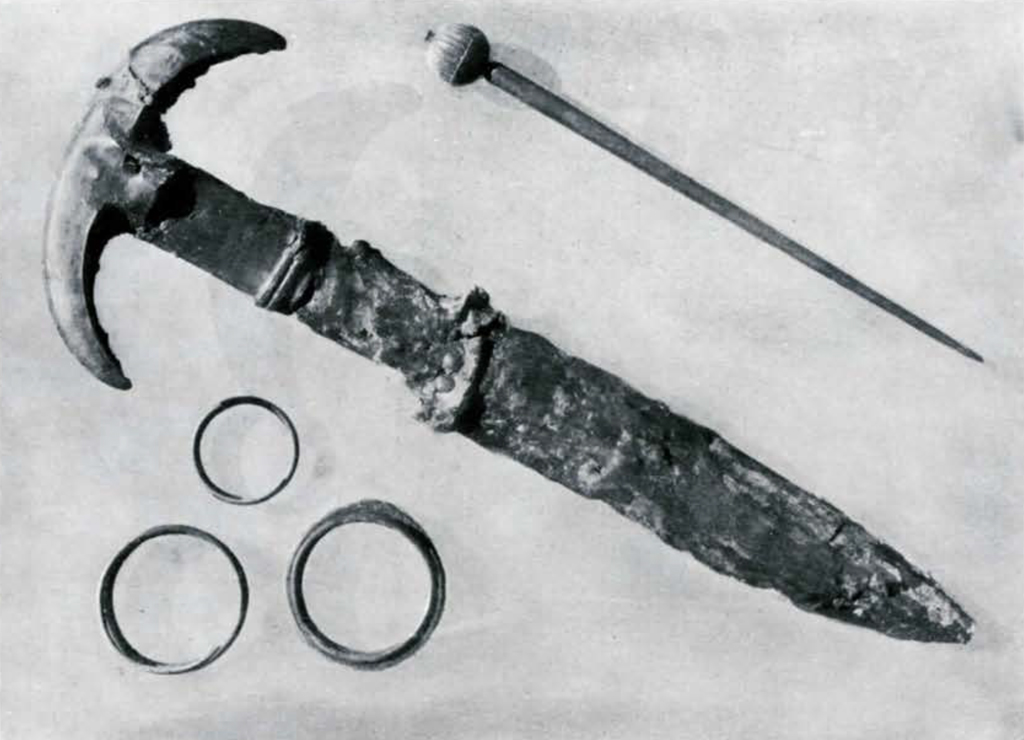
Image Number: 206192, 8960a

Image Number: 190962, 8954
First Shaft Grave (C)
The next excavation was that of a grave unique so far in this cemetery. Instead of the usual single burial we have a large trench. The burial pit covers an unusually wide area (40 x 17 feet); the grave itself, which seems to be a vault built with plano-convex brick and stone, was first left untouched, and all our discoveries so far have to do with the wider area of the pit. Apparently after the body was laid in the grave and a certain amount of earth had been put back, the general offerings, etc., were placed in the shaft above the grave. With the offerings were put the bodies of a large number of people who must have been sacrificed in order that they might accompany the king to the next world.
The first object found was a harp elaborately inlaid. The upright, about four feet high, was of wood capped with gold and with a broad gold band at the base and a shoe of bitumen; the keys in it were of copper with gold-plated heads. The edges of the base board were inlaid with a narrow gold beading between two strips of lapis. The sounding box was of wood having round its edges a band of incrustation in shell enriched with lapis and red paint. The far end of the body was encased in silver and ends in a magnificent head of a bullock made of gold with the curls between the ears and the elaborate “false beard” worked in separate bits of carved lapis, while the eyes are of lapis also. There were twelve strings. The front of the sounding board was decorated with big shell plaques engraved with mythological scenes. The woodwork had all perished but can be restored with perfect accuracy, for the inlay had been kept in its place by the soil, and by pouring plaster into the hole left by the decay of the upright we were able to make a cast which preserved the position of the keys; the silver plating of the front of the body is the only serious loss.

Image Number: 206193
Then came thirteen bodies laid in parallel rows except for one which was crouched up against the harp, probably the harpist; two of these were children, the rest women wearing identical headdresses of gold ribbon, beads, and gold leaves; they had none of the normal funerary furniture. Coming nearer to the middle of the grave we have found a set of four arrows with large gold heads and shafts bound with gold and silver, a set of four spears with copper heads and gold and silver bound shafts, and others not yet fully excavated. Next was a shallow trench containing the bodies of five men, also without the normal furnishings. Then came a discovery astonishingly like Herodotus’s account of the burial of Scythian kings; there was a chariot of inlaid wood decorated with small gold heads of oxen and lions, twelve in all, along the top rail, six large lions’ heads on each side of the body, these of gold with manes in lapis and shell, two large panthers’ heads of silver in the front and two smaller silver lions’ heads on the freeboard. To the chariot were harnessed two asses which wore collars of copper decorated with a large eye pattern; between them was the rein-ring from the pole, of silver, on which was a ” mascot ” in electrum, the figure of a donkey in the round, a finer piece of realistic animal sculpture even than we get on the wall reliefs of the late Assyrian kings. Three dead grooms lay holding the asses’ heads.
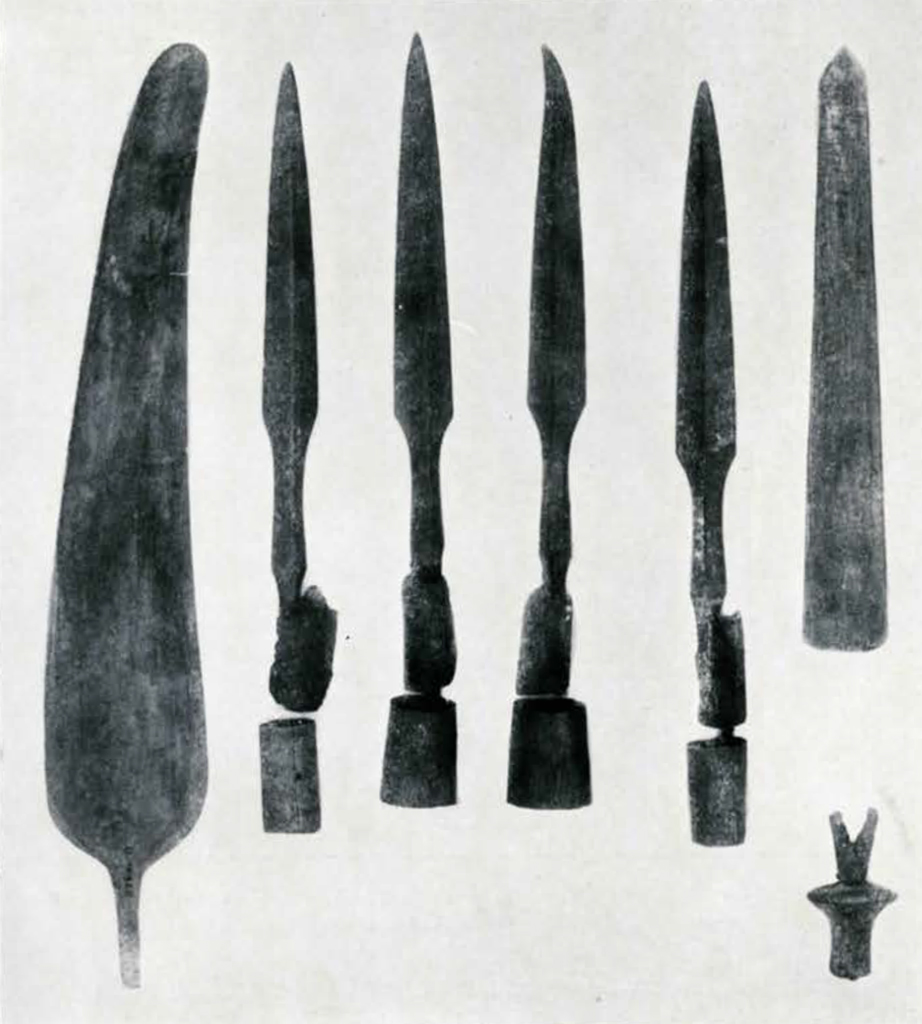
Near the chariot was a gaming board (not so fine as last year’s) complete with its two sets of gaming pieces and dice; of the former one set consisted of seven shell plaques with engraved animal scenes. One set of dice is of shell with lapis dots, the other of lapis with gold dots. Close to this was a wooden box, measuring about 2.99 m. by 0.90 m., decorated along the front with a mosaic in shell and lapis unfortunately quite ruined by the decay of the shell, and with a band of gold inlay; this was empty, and had probably contained clothes. Round the box lay a mass of offerings of all sorts: scattered beads, a pair of tweezers and a stiletto in gold, a fine engraved and inscribed lapis cylinder seal, a sceptre in gold and lapis with a silver head, clay vessels, two large silver lions’ heads perhaps from a stool, copper vessels and tools, stone vases to the number of thirty or more, including an oval bowl of obsidian, a cup in lapis lazuli, two decorated pots in steatite and a vase in black and white granite, a set of gold chisels, a gold saw, some thirty silver vessels, mostly in good preservation and including many new shapes, and four magnificent gold vases, two of them elaborately decorated with fluting and engraving.

Image Number: 8978, 8979a, 206766

Museum Object Number: 31-18-7
Image Number: 8981
The Plundered Tomb (C)
The large grave area had yielded many fine objects but failed to produce the actual tomb and body of the principal person. Among these objects was the wooden chest which I assumed to be a clothes box. When the box was removed there were found below it bricks which proved to come from the arched roof of a stone and brick-built tomb; it had been plundered from above and the box served to conceal the hole made by the plunderers. From the wreckage of this we recovered a few small gold objects, including a frontlet made of two lengths of gold chain and three large beads, a very fine gaming-board encased in silver, all the shell squares of the face engraved with animal subjects, and a most remarkable model sixty centimetres long of a boat, in silver, complete with oars and awning-support. Much as one must regret the looting of the chamber, this loss is perhaps compensated by the survival of the chamber itself, for it is an extraordinarily interesting architectural monument. The walls are of rough stone built up between caissons with mud mortar; at one point the wall line is broken by a doorway arched with brick. Along the top of the stone wall a single course of bricks was laid, and from this rise the springers of the arches which form the vault. Both door and vault are made with true arches; the bricks are plain, not voussoir-shaped, but fragments of brick or pottery are inserted in the upper part of the joint to secure a radial angle; the vault is simply a succession of such rings. But at the ends of the chamber instead of the arch coming flush against the end wall an apsidal form is produced: the roofing bricks are laid flat, or rather, on a slight and gradually increasing slope, and are stepped out one beyond the other below it, and, starting with a single brick laid across the corner from wall to wall, the angles are rounded off and the square end of the room is transformed into a semicircle whose roof is a half dome, a mixture structurally of true domical building and corbel work. It results that at the date of these tombs, well back in the fourth millennium B.C., the Sumerians were acquainted with the corbel vault, the true arch, and the pendentive dome. The discovery that this is so is perhaps more important than that of any of the objects.

Museum Object Numbers: 31-18-1 / B17692
Image Number: 8976c

Image Number: 8917
Second Shaft Grave and Tomb of Queen Shub-ad (D)
Behind the tomb just described there was another chamber built of stone and roofed with brick : constructionally it is not part of the same building but is only abutted on it. This masonry tomb stood at one end of a second large grave area very much like that described above, lying about one and a half metres lower down, and unplundered. In this area were buried fifty-eight persons, all of whom must have been sacrificed to the man buried in the tomb proper. A sloping ramp led down to the bottom of the grave shaft, which had been carpeted and hung with matting; on the slope lay the bodies of the six soldiers of the guard wearing copper helmets and carrying spears—the skulls, though crushed, have been preserved by us complete with the helmets. At the foot of the ramp were drawn up two heavy wooden four-wheeled carts or chariots each drawn by three oxen wearing silver rings in their noses and broad decorated silver collars, attached to poles surmounted by “mascots” in the form of bulls and harnessed with reins made of large silver and lapis beads. The skulls of all these animals and the complete body of one have been preserved. The grooms and drivers were found in their places; one of the former had a dagger with gold decorated hilt.
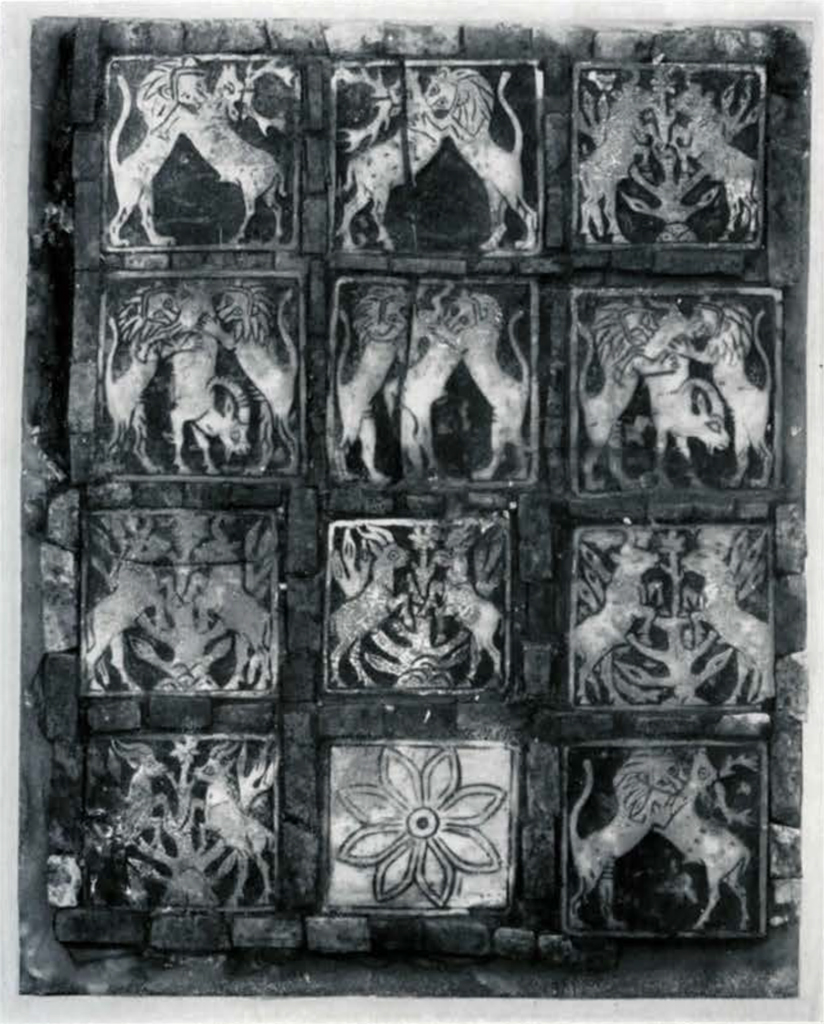
Image Number: 8965, 9252
Against the side of the shaft were two statues of bulls; the bodies, made of wood, had entirely decayed; the head of one was of copper with inlaid eyes, a very fine piece of work in excellent condition; that of the other was of gold and lapis, the head itself being of thin gold over wood, the hair, beard, eyes, and tips of the horns of lapis. The head is badly crushed and distorted, but can easily be restored. Down the chest of each animal ran a series of shell plaques engraved with mythological scenes.
The whole of the rest of the shaft area was littered with bodies. Against the foot of the tomb lay eleven skulls, presumably those of the principal women of the harem, each wearing an identical elaborate headdress consisting of gold ribbon making a sort of net over the hair, a wreath of beads with mulberry leaf pendants, very large gold earrings, and a silver head ornament shaped rather like a hand with at the tip of every point a rosette having inlaid petals of gold, lapis, and shell. The other bodies were less richly adorned, but gave a great number and variety of beads, pins, etc. The present chamber, unplundered, is that of a queen named on her lapis cylinder seal “Shub-ad”; the seal of one of her grooms inscribed ” Lugal Shag-pad-da ” may identify her husband. I am strongly inclined to believe that her tomb is slightly later in date than the first plundered vaulted tomb (though the floor level is rather lower) and is to be connected with the grave area (C) described above; in fact, I believe that here we have the missing tomb to which that area was an appanage. In that case the plundered tomb is that of the (nameless?) king, her husband. His queen was buried after him but as nearly as might be in the same grave, though with an independent shaft and individual sacrifices.
The tomb of the queen produced a very great number of objects. There are two plain oval gold bowls, one with a wire handle, one fluted gold bowl, and a gold strainer. A pair of cockle shells in gold and another in silver were among the toilet utensils. There were eighteen silver tumblers, fluted and engraved, a silver jug, a silver bowl with a gold drinking-tube and another with the drinking-tube covered with lapis, many silver bowls and saucers, about thirty stone vessels and many in copper. With these was a very finely modelled bull’s head in silver, from a statue, with shell plaques on its chest; the wooden body had disappeared.
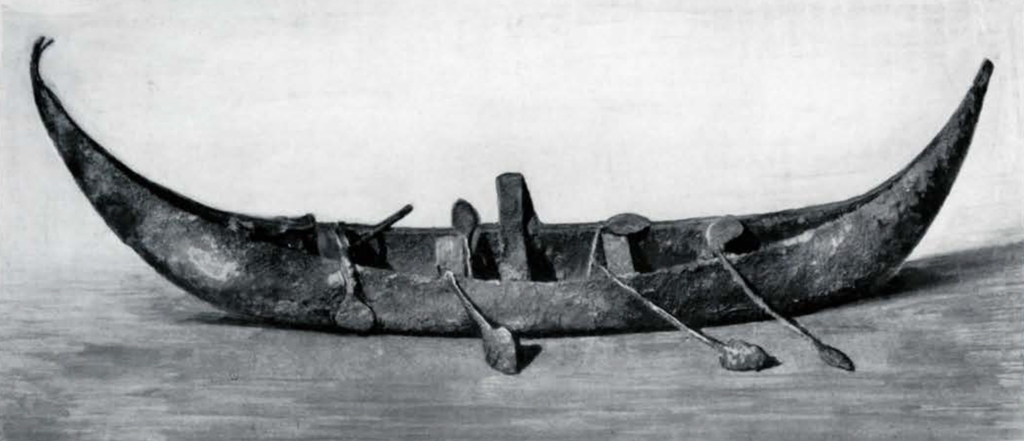
Image Number: 191067

The body of the queen lay on a wooden bier, almost hidden beneath two huge votive lamps of silver. Round the knees were garters of lapis and gold beads; on the hands were ten gold rings, seven with a simple cable design in gold, three inlaid with lapis. The upper part of the body was entirely covered with a mass of beads in gold, lapis, carnelian, and agate, which had formed a beaded cloak fastened over the right shoulder and arm; the beads were of course all loose and much disordered, but the general design of the cloak could be made out and it should not be difficult to reproduce it fairly faithfully. The fastenings were composed of three large gold pins with lapis heads, to each of which was attached a big lapis cylinder seal; by the fastening, on the right arm, were three amulets in the form of fish, two in gold, one in lapis, a gold amulet in the form of two seated antelopes, and, by the shoulder, one of lapis in the form of a reclining calf hung on big beads of lapis and agate. Round the neck was a “dog-collar” made of gold and lapis triangles and small beads. On the head was an elaborate headdress so large that it could only have been worn over an artificial wig; a broad gold ribbon passed several times round the lower part of the head, in a gentle spiral, and two strands of it passed over the crown to the nape of the neck; a triple string of beads from which hung large gold rings ran across the forehead; above this was another string with big mulberry leaf pendants of gold; above this again a third string of gold and lapis beads with small drop pendants, long slender gold leaves like willow leaves in sets of three, and gold flowers with inlaid petals of blue and white. From the back of the head rose an ornament rather like a Spanish comb, a pin broadening to a triangle having seven long thin points connected by wires, and at the end of each point a large rosette with inlaid centre; this was also of gold.
This headdress is really an elaboration of that worn by the ladies whose bodies have been found in the sacrificial annex of the two large royal tombs; by the side of the bier was another of a sort hitherto unique. This consisted of a fillet, apparently of thin leather, to which were stitched minute beads of gold and lapis covering the whole surface. Against this background were small gold rosettes, “palmettes” of thin twisted wire, branches of shrubs in gold with gold and carnelian pods or fruit, bunches of pomegranates, three fruit and three leaves, most naturalistically rendered, ears of corn in gold, and four pairs of seated gold animals, stags, rams, antelopes, and bearded bulls. It is a marvellously delicate piece of work.
The earrings actually worn in the ears were spirals of gold wire; in the hair, under the gold ribbon headdress, there were enormous “earrings” with lunate ends, as much as eleven centimetres in diameter; the total weight of the headdress must have been very oppressive.
Among objects from other graves I would remark a very beautiful alabaster lamp with a figure of a man-headed bull carved on the side.

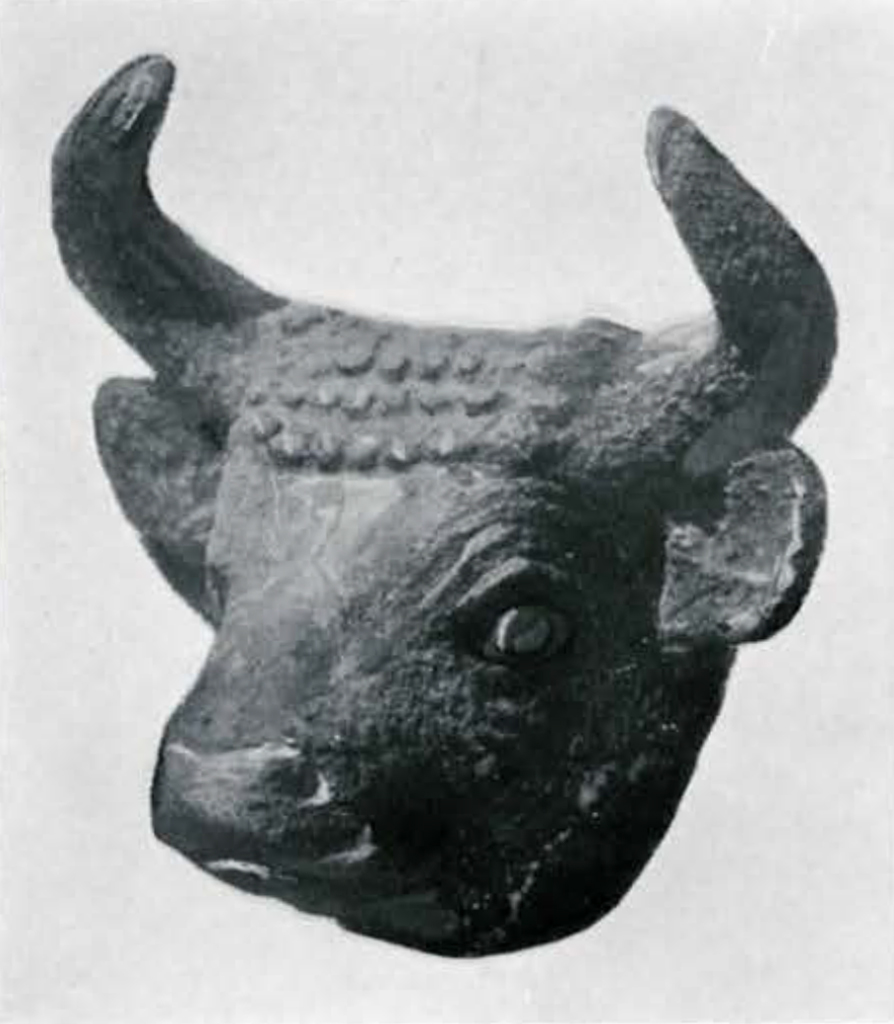
Plundered Tomb below that of Mes-Kalam-Dug (E)
A patch of limestone rubble had been discovered close to the grave of Mes-Kalam-Dug; digging down below this, more stonework was found and it became evident that there was here another royal tomb: the stepped dromos was found, cut in the soil and leading down to a door in the stone wall, the bodies and arms of the soldiers lying at the bottom of the slope; but it was clear that the tomb extended under the unexcavated soil and its clearing would demand considerable labour as the tomb floor lay forty feet below the modern surface and immediately under part of our spoil-heap of last season. A large number of men were employed throughout one whole week and the tomb was finished on the following Saturday evening.
The grave shaft, measuring twelve metres by eight, was entirely occupied by the tomb, which consisted of three parallel chambers all built of rough limestone; it is most interesting for the history of architecture, for the roof is of corbel vaulting, perfectly preserved, and at the end of the chamber takes an apsidal form, the corners of the building being rounded off with rough pendentives to support a half dome; the rest of the roof is barrel-shaped. Judging from its position—it lies below the grave of Mes-Kalam-Dug—it is one of the earliest we have yet found, and while it must be one of the first instances of real building in stone its builders were acquainted with such complicated forms of architecture as the vault and the dome. I estimated that over four hundred cubic feet of stone were used in the building, all imported stone, probably from the Gebel Sinam, south of Zobeir, a. distance of 110 miles as the crow flies. The central chamber was divided into two parts, the inner of which had probably contained the king’s body; in this and in each of the side chambers there was a shallow rectangular depression in the cement floor the size of a coffin, and at each corner of it a round hole as if for the supports of a canopy. The walls and roof had been plastered with a smooth coating of lime cement, and the floors were of the same. The roofs, of which in each case the apsidal northeast end was well preserved, stood two metres high. It is the finest of the built tombs yet found by us.

Museum Object Numbers: B17693
Image Number: 142231, 8974a

Unfortunately it had been plundered, and that probably not long after the burial, for the robbers had thought it worth their while to remove objects of every class, whereas had any very long period elapsed the copper and silver vessels would have been so far decayed as not to merit removal. We found only what the thieves had dropped or overlooked. A small gold cup of thin metal a good deal distorted by the fall of the roof was found in the third chamber; in the central chamber were two curious objects, imitation ostrich egg shells, one in silver and one in gold, the former crushed and in bad condition, the latter scarcely dented; both had been encrusted with shell, lapis, and red stone set in bitumen, and the decoration, which had fallen away, I have been able in the case of the gold shell to replace in its original form. There were several real shells similarly incrusted, but these were very badly broken up. The third chamber produced part of a gaming board made of shell plaques framed in lapis and set in silver; it is only a fragment, but the engraving on the plaques is very good; these have been re-set for the most part in their original order. With them were found some of the “men” also engraved. In a corner of the same chamber, against a human skull entirely covered with minute lapis beads lay an object which is perhaps the most important that we have yet found. It is best described as a stela, made of wood, fifty centimetres long and twenty centimetres high and about four centimetres thick; both sides and the ends are covered with mosaic. On each side there are three registers divided and bordered by a minute diamond pattern in white, red, and blue; each register has a row of human or animal figures silhouetted in white shell against a lapis lazuli background, the internal details of the figures being rendered by engraved lines filled in with black or by red inlay. The subject on one side is the Sumerian army on the march, footsoldiers and chariots; on the other side there is a banquet scene, the king and his family seated in the top register, in the others, servants bringing the materials for the feast, driving up cattle, carrying fish and so on. I regret that I cannot send photographs of this remarkable piece. As it lay in the ground the upper face (the army scene) was almost intact and only at one end of the middle register had the mosaic been seriously displaced by a stone which had been forced through it (the wood had of course decayed away and there was nothing to keep the tessera in position). This face had to be waxed and bandaged bit by bit as it was exposed. The lower face had suffered more severely, and part of it came away with the front panel; this can of course easily be replaced and the whole can be restored, but the work is such as should not be attempted under field conditions. But I see no reason why the stela should not be turned out in perfect condition, and in general interest it will, I think, rank above any Sumerian antiquity known.
The prophecy made by Mr. Woolley of a successful season and of discoveries “which will eclipse those already made” has been realized.

Museum Object Number: B16693
Image Number: 8983

Museum Object Number: B16684
Image Numbber: 8986b
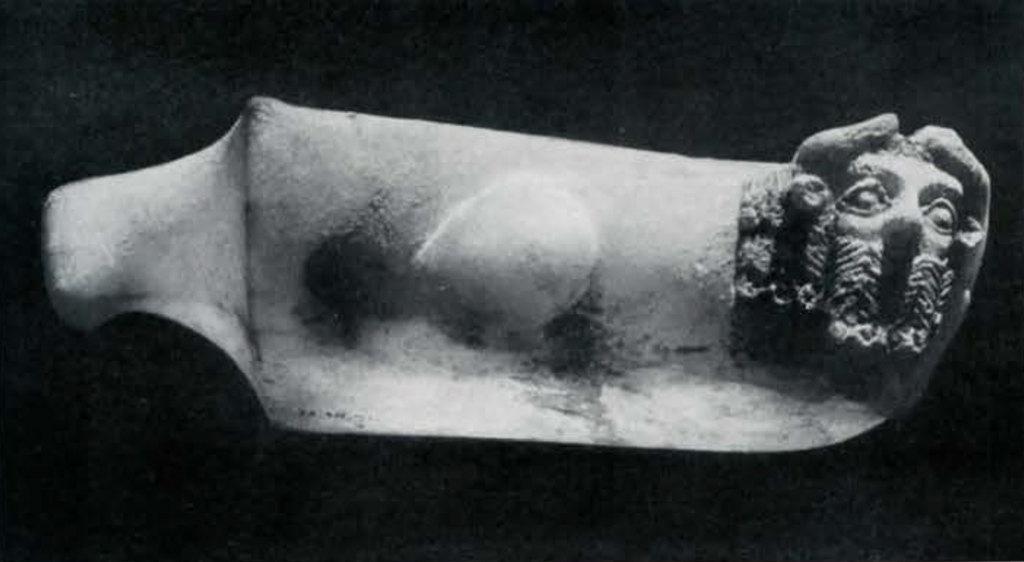
Museum Object Number: B17087
Image Number: 191061


Museum Object Number: B16692
Image Number: 8966b

